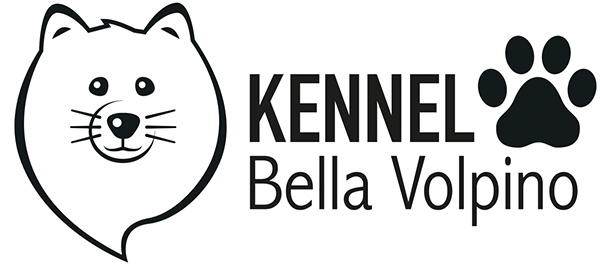Hints, tips and recommendations on how to care for your Volpino Italiano.
The teeth has to be taken care of from day one. Make it a habit of taking the dog on your lap every day and use a toothbrush or “finger toothbrush” on all the teeths. In this way you avoid the dog gets plaque that does not look particularly pretty. And it’s not healthy for the dog’s overall oral health. Pay close attention when your puppy around 4-6 months of age changes teeth. It is important to keep an eye on that the baby teeth fall out before or very soon after the permanent teeth have come up. Since it can damage the bite, if allowed to go with double teeth for long. If they don’t fall out bye themselves, contact your veterinarian to get the baby teeth pulled out.
On all dogs there are some tears running from their eyes daily, but it is more easily seen on a white dog. So every day, for example. morning and evening wipe the dogs eyes with a dry cotton ball. If the eye area begins to get dark/brown under or around the eyes, is a dry cotton pad not enough. Contact your breeder for advice for what you should do to help this go away again.
Despite the voluminous white fur, there is not much grooming on a Volpino. Don’t wash it any more than 2-3 times a year as needed. (Unless you go to dog shows, then you will wash the dog more often, so it will appear completely white and shining clean in the show ring) You only need to brush the coat 3-4 times a month, though when the dog switch fur (normally two times a year) I recommend a little more often, so you can take a portion of the fur in the brush, rather than on the floor. And avoid accumulating of lumps of undercoat. While it is a puppy, I recommend that it is brushed several times a week but less thoroughly, to help the puppy to become accustomed to be brushed. The same with bathing … wash it 1-2 times a month, the first 6-8 months. Just in plain water without soap, and not so the fur gets soaked. All this so the pup get used it, and not later, will be sorry to be brushed and bathed.
The Volpino do not need to be cut / trimmed, the only thing to be cut, is the fur between the pads. This is done only approximately once a month or as needed (in the first months in which the puppy develops a lot, the fur grows faster than it will do when the dog is adult, so the fur between the pads has to be trimmed more often) Just make it a habit, approx.. once a month to cut the nails (see diagram) and also cut the fur between the pads (see pictures below). Wash the feets well off before, so the nails are clean, you can then clearly see the vein, so you can avoid cutting too far up.

photos courtesy of Bitta Wöhliche
Primær Linseluksation
Hos nogle volpinoer har man konstateret, at de er bærere af PLL . Primær Linseluksation er en arvelig og smertefuld øjensygdom, der medfører blindhed. Når de fine tråde, som øjets linse er ophængt i, brister, vil øjets linse flytte sig i forhold til sin normale placering, og i de fleste tilfælde afstødes øjenlinsen, der både kan falde forover og bagud. Falder linsen bagud er det som regel ikke nødvendigt at operere.
DNA-test for Primær LinseLuksation (PLL) Det lykkedes den engelske forskningsinstitution Animal Health Trust (ATH) i 2009 at identificere selve mutationen, der er årsag til til PLL. Derfor er det nu muligt at DNA-teste for PLL. Testen er en skrabprøve man tager i mundhulen, som er ganske nem og aldeles smertefri for hunden. Prøven undersøges af et autoriseret laboratorium og kan give følgende resultater:
Fri: Hunden har intet genetisk anlæg for sygdommen, og kan ikke få eller videregive PLL.
Bærer: Hunden bærer et muteret gen og et rask gen. Hunde som har fået resultatet bærer, kan godt bruges i avlen. Hvis man vælger at bruge en hund i avlen som er PLL bærer, er det en god ide at finde en partner som er fri for PLL, så afkommet ikke får det syge gen fra begge forældre.
Påvist: Hunden er bærer af begge gen for PLL. Det betyder at hunden har en stor risiko for at udvikle Primær Linseluksation.
Hvorfor DNA-teste for PLL? PLL er en smertefuld sygdom for hundene, og nu hvor vi endelig har muligheden for at teste for det, hvorfor så ikke gøre det? Vi ved nu at der er en del bærer, men ikke præcis hvor mange, så det er vigtigt at man som opdrætter er opmærksom på problemet, så vi kan komme problemet til livs. Der er ingen som er interesseret i at aflive sit elskede kæledyr, pga en sygdom som kunne have været undgået. Så når du som købere er på udkig efter en hvalp, så gør dig selv den tjeneste at spørge om forældredyrene er testet og evt. se dokumentation derfor. PLL testen er billig (350 kr), så der findes ingen gode undskyldninger for ikke at teste sine avlsdyr!
